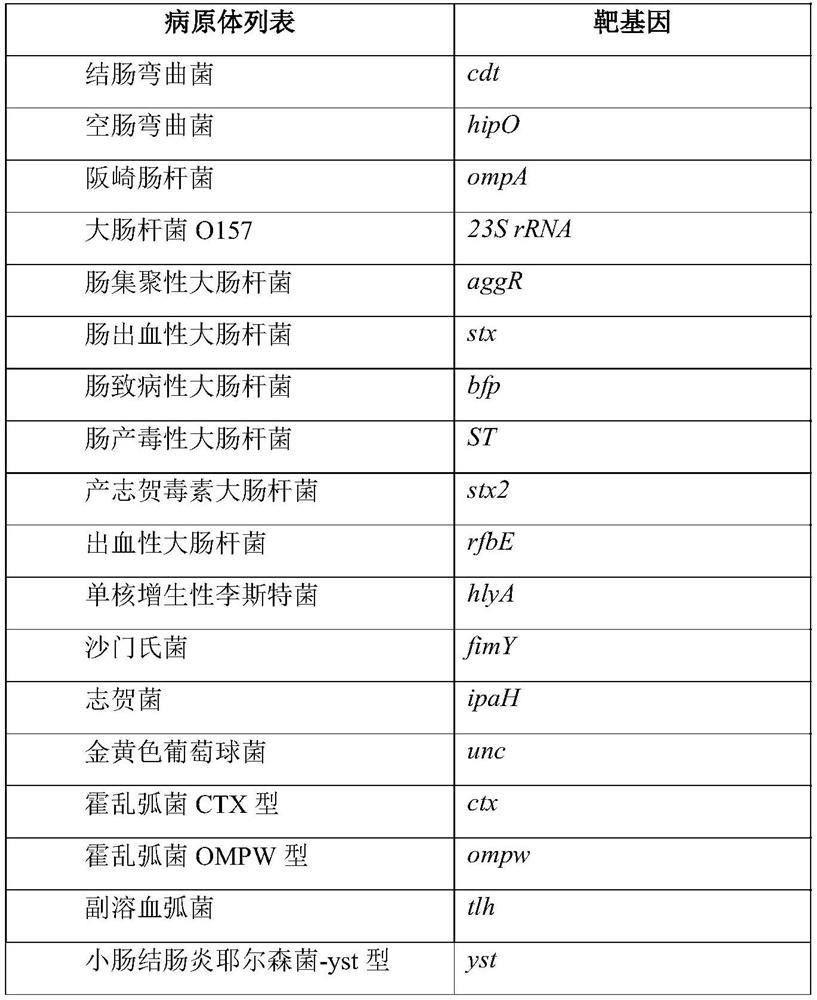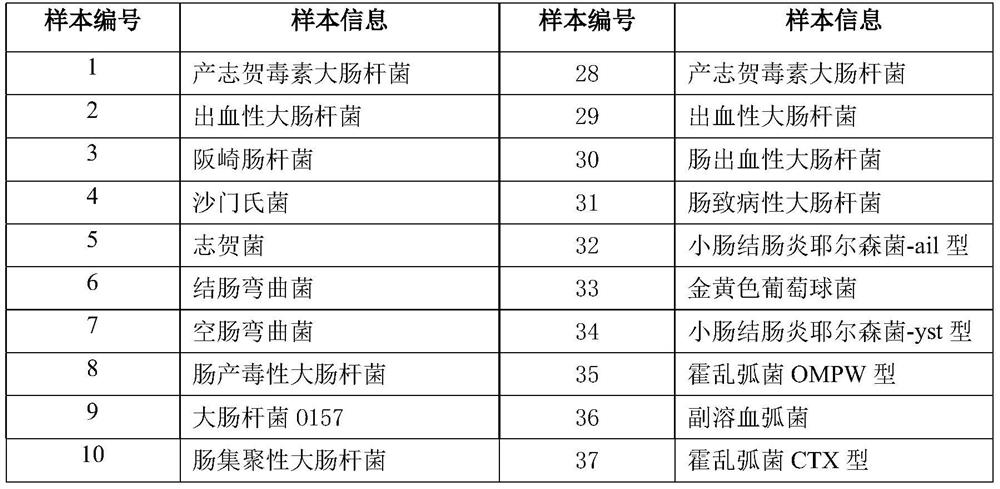Kit for simultaneous detection of multiple food-borne pathogenic bacteria and its application
A technology for food-borne pathogenic bacteria and pathogenic bacteria, which is applied in the directions of microorganism-based methods, microbial determination/inspection, microorganisms, etc. Problems such as few types of sex tests
- Summary
- Abstract
- Description
- Claims
- Application Information
AI Technical Summary
Problems solved by technology
Method used
Image
Examples
Embodiment 1
[0087] Embodiment 1: the extraction of sample nucleic acid
[0088] According to the national standard or industry standard method, the microorganisms in the food samples are enriched and cultured, and the bacterial DNA is extracted from the enrichment solution using a commercial bacterial genome DNA extraction kit. A total of 54 nucleic acid samples were extracted, of which 38 were positive samples with known subtypes, 10 were negative controls, and 6 were irrelevant bacterial samples. Specimen information is as follows:
[0089]
[0090]
Embodiment 2
[0091] Example 2: Preparation of Gene Chips for Parallel Detection of Foodborne Pathogenic Bacteria
[0092] First add a section of 8-20bp poly T to the 5' end of the above 19 probes, and carry out amino modification at the same time, dilute the probe with deionized water, and mix it with spotting solution in equal volume, so that the final concentration is 75pmol / ul , make the system dot matrix by cartesian microarray on the surface of the aldehyde-modified glass slide, place it at 75% relative humidity, and fix it at room temperature for 48-72 hours; after taking it out, put the slide in 0.2% SDS and shake and wash for 2min. Take it out and fully dry it at room temperature, then place the slide in sodium borohydride solution and shake for 5 minutes to remove free aldehyde groups; wash with 0.2% SDS for 1 minute, repeat twice, and finally soak in pure water for 2 minutes and dry in the air; The gene chip for parallel detection of food-borne pathogens with 19 probes is complet...
Embodiment 3
[0093] Embodiment 3: PCR amplification and hybridization
[0094] Add the above-mentioned sample nucleic acid (one cartridge to detect one sample, and a blank control is also provided as needed. In order to test the repeatability of the reagent, each sample is repeated three times) from the sample addition hole into the cartridge, and the cartridge All reagents required for PCR amplification, hybridization detection, and cleaning are pre-installed, and the genetic chip for parallel detection of pathogenic bacteria prepared in Example 2 is also pre-placed in the hybridization detection groove at the bottom of the cartridge. Put the cartridge into the cartridge processor, write the reaction program from the system control software, run it, and the instrument will automatically perform PCR amplification and hybridization.
[0095] (1) Qiagen Multiplex PCR Kit, Cat No.206143 was used for PCR amplification, two rounds of PCR amplification were performed, and the configuration of th...
PUM
 Login to View More
Login to View More Abstract
Description
Claims
Application Information
 Login to View More
Login to View More - R&D
- Intellectual Property
- Life Sciences
- Materials
- Tech Scout
- Unparalleled Data Quality
- Higher Quality Content
- 60% Fewer Hallucinations
Browse by: Latest US Patents, China's latest patents, Technical Efficacy Thesaurus, Application Domain, Technology Topic, Popular Technical Reports.
© 2025 PatSnap. All rights reserved.Legal|Privacy policy|Modern Slavery Act Transparency Statement|Sitemap|About US| Contact US: help@patsnap.com



